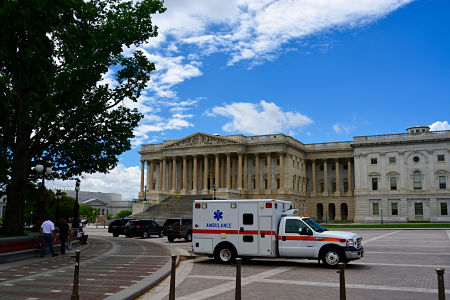District of Columbia Fire and EMS Chief Gregory Dean is being forced to think outside the box.

Chief Dean said his agency is inundated by 911 calls and he has appointed a task force to explore whether ride-hail services such as Uber and Lyft could be used to handle non-emergency transport needs.
Dean told D.C.’s NBC affiliate that he is considering using nurses in the 911 call center to evaluate medical needs and route non-emergency calls to ride-hail and other transportation services.
“We are working with the health department to find other ways to transport people, such as using a contract taxi cab or Uber," he said. "We are trying to find creative ways to try to reduce the strain on the system."
Dean said his agency dispatched more than 160,000 responses to 911 calls for EMS in 2015. An analysis showed many of these calls were not high-priority emergencies.
He said when 911 callers ask for help his crews are dispatched, even if the situation does not always warrant a full response.
He said he plans to have recommendations from a task force back by October and wants to implement his plan next year.
Uber works with local governments in several locations across the country to give rides to seniors, supplement public transportation and discourage drunken driving, according to the company.
Chief Dean took the FEMS post in 2015 after a much publicized evaluation of the agency’s EMS response times.
“Upon arriving, I embarked on a six-month process to review and evaluate the department to better understand operations and set a new course for the future. After decades of underinvestment, poor training and a lack of leadership, I knew there would be no easy answers,” he said. “I also knew we would need bold solutions to break up the status quo. I heard loud and clear from the mayor, D.C. officials and residents that the community’s demand for emergency medical services had outpaced the department’s ability to deliver them. EMS call volume had climbed 20 percent since 2010, but EMS resources remained stagnant. We spent our days chasing calls and trying to get our units back from the hospitals.”
In March, D.C. entered into a contract with American Medical Response (AMR) to transport patients from 7 a.m. to 1 a.m. seven days a week.
“On its own, this contract will not reform our EMS system, but it is a critical step. Supplementing our resources with a third-party provider will enable us to create a more effective system that matches the right resources with the right calls. It will allow us to better meet our response-time goals, more frequently train our providers, preserve resources for our highest-acuity patients, provide better field supervision and performance evaluation, do preventive maintenance on our fleet and improve the agency culture around EMS,” he added.
In the first week of operations, AMR cut FEMS’ non-life-threatening transports almost in half. The private ambulances transported about 90 people a day, according to D.C. Fire and EMS.
D.C. Fire & EMS will continue to transport patients with life-threatening or time-sensitive conditions, such as cardiac arrest, stroke, major trauma and unconsciousness. AMR will transport patients with minor injuries or illnesses, such as colds, sprained ankles and "general non acute sick calls.”
Dean said the service will help reduce delayed 911 responses and give D.C. firefighters and paramedics more time for much-needed training.
